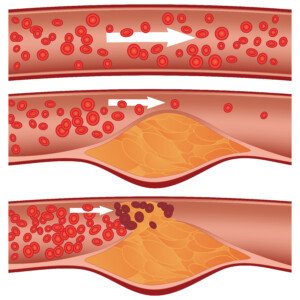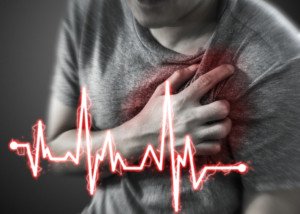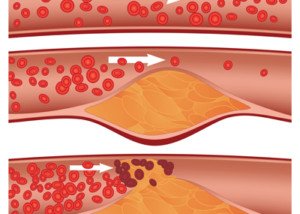
Here is a careful explanation of how a young, fit athlete could drop from a heart attack.
Assume the athlete is not on any drugs or medications, and does not have a congenital heart defect.
Assume he or she is very physically fit and may be competitive, even elite, or just a passionate gym rat, mountain biker or runner.
They then suffer a heart attack. HOW?
Dr. Cynthia Thaik, MD, says that “most acute coronary artery syndrome or events occur in arteries that have 30 percent plaque or less until the time of the coronary event.” Dr. Thaik is a cardiologist and author of “Your Vibrant Heart.”
In other words, these heart attacks occur in people whose coronary arteries are equal to or less than 30 percent clogged with plaque.
This is difficult to digest, because you’ve probably always associated heart attacks with completely blocked arteries or “very clogged” arteries that have only a tiny inside diameter for blood to flow through.
And these heavily clogged arteries, sludged up with plaque, are not what’s usually going on inside the hearts of younger, fit adults.
How a Heart Attack Happens in a Young, Fit Athlete
Dr. Thaik explains, “The mechanism is plaque instability and plaque rupture leading to platelet aggregation and acute thrombosis, such that the 30% stenosis progresses to 100% stenosis in a matter of minutes.”
Okay, let’s reword that in a language closer to English, according to Dr. Alvaro Waissbluth, MD, a cardiologist with Alameda Health System in CA.
“When a rupture occurs, your body tries to fix it by creating a plug,” begins Dr. Waissbluth, “just like if you cut your arm you will develop a clot and a scab.” This happens with a plaque rupture.

Shutterstock/Diamond_Images
“Most of the time the plug seals the tear and then the plaque is fixed and nothing happens,” continues Dr. Waissbluth.
“BUT if the plug grows and grows it can get very large and shut down the entire artery, and this is how a major heart attack happens.”
Recall that Dr. Thaik points out that this phenomenon occurs in seemingly fit, younger people who have a 30% or less blockage.
However, Dr. Waissbluth says, “Most heart attacks occur when a plaque blockage is in the 30-50% range and the outer layer of the plaque gets a small tear in it – a rupture.”
Well, this isn’t an issue of which is closer to the reality: under 30% or between 30 and 50%.
The issue is that these cardiac events occur via a mechanism “by which someone young and fit without any prior symptoms or knowledge of disease can suffer a massive heart attack and even suffer sudden death as their initial presentation,” explains Dr. Thaik.
“Athletes are particularly at risk if they are dehydrated during their physical activities.”
All of this may still not make much sense — until you realize that there are two kinds of plaques inside coronary arteries: soft (unstable) and hard (stable, calcified).
“The longer a plaque has existed and the bigger the plaque,” says Dr. Waissbluth, “the more stable its surface tends to be.”
Dr. Waissbluth goes on to point out that more major heart attacks result from blockages in the 30-50% range versus blockages filling up 80% of an artery.
So though not all cardiologists agree on the exact percentage range that’s the highest risk for plaque rupture, the common denominator is that newer plaques—those that have not been around that long in terms of cardiac time—are soft and can break apart (rupture).
Meanwhile, old plaque that has grown over time (80% blockage) is hard and not prone to breaking apart.
All of this contradicts the idea that exercising and preventing your arteries from clogging up is how to lower the risk of heart attack. However, you must step back and view the big picture.
In the grand scheme of things, people who don’t keep fit, who let their bodies turn to mush, who avoid working out, and especially those who smoke and develop diabetes, are asking for some very serious cardiac trouble down the road.
You can even have a heart attack without blocked arteries.
Keep working out. Keep running, biking, climbing, jumping and lifting. BUT…realize that what you eat is an enormous factor in whether or not you accumulate risky levels of soft plaque.
The fewer processed foods you eat, the healthier your heart will be.

Dr. Thaik’s clinical interests include congestive heart failure and women’s heart disease, and is affiliated with the American Heart Association.

Dr. Waissbluth has been in practice for 25+ years and is board certified in interventional cardiology and cardiovascular diseases. He is founder of Eat Tank, an educational nutrition initiative that provides simple tools and practical knowledge for better understanding food.
 Lorra Garrick has been covering medical, fitness and cybersecurity topics for many years, having written thousands of articles for print magazines and websites, including as a ghostwriter. She’s also a former ACE-certified personal trainer.
Lorra Garrick has been covering medical, fitness and cybersecurity topics for many years, having written thousands of articles for print magazines and websites, including as a ghostwriter. She’s also a former ACE-certified personal trainer.
.
.









































